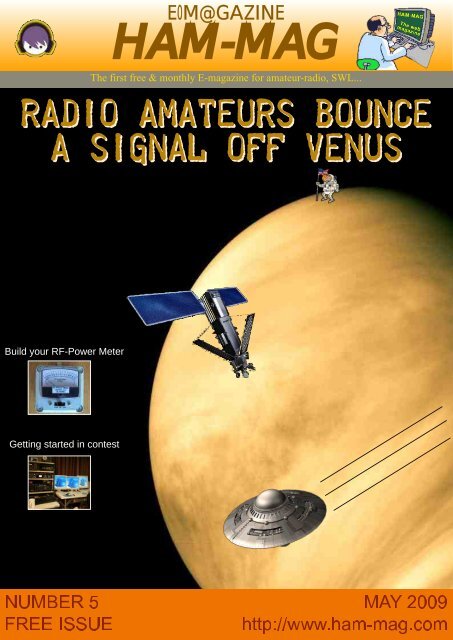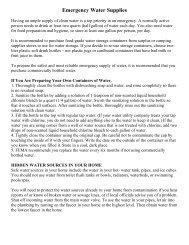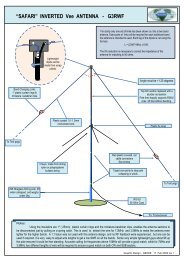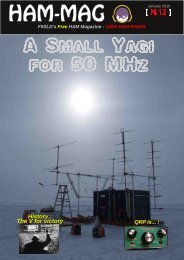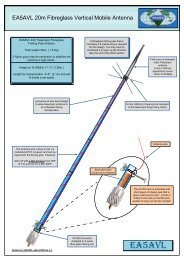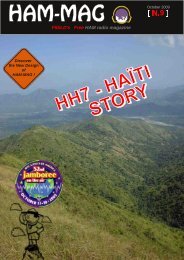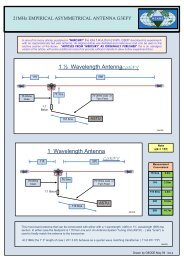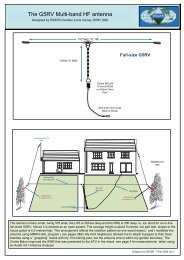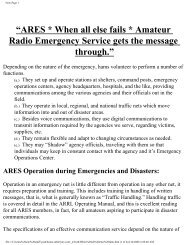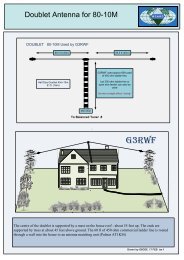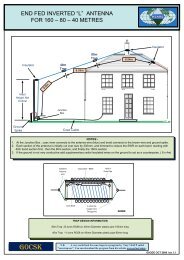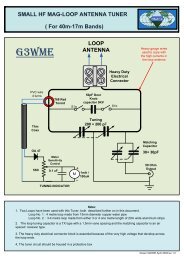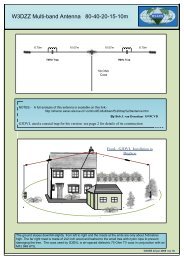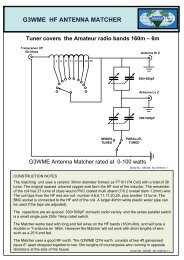HAM-MAG - WNYDXA
HAM-MAG - WNYDXA
HAM-MAG - WNYDXA
Create successful ePaper yourself
Turn your PDF publications into a flip-book with our unique Google optimized e-Paper software.
E-M@GAZINE<br />
<strong>HAM</strong>-<strong>MAG</strong><br />
The first free & monthly Emagazine for amateurradio, SWL...<br />
Radi o Amateurs Bounce<br />
a Si gnal off Venus<br />
Build your RFPower Meter<br />
Getting started in contest
The HamMag Hall of fame............................................ 3<br />
PHONETICS By WØGDS............................................. 4<br />
Getting started in contest By WØRAA...................... 8<br />
The "NOGO" Kit By KA5DON................................... 9<br />
RF Power meter Dumy load By ON6MU............. 11<br />
EVE A Signaf "off" Venus By DB2OS................. 14<br />
The DXnews from the Web..................................... 16<br />
The DX Calendar By SM3CVM............................... 18<br />
CQ contest de YJØAX By VK4TI........................... 21<br />
A PIC16F84 based CW Decoder By IK3OIL......... 24<br />
A Double Quad Ant. 1296 MHz By DL5NEG........ 29<br />
Comic's <strong>HAM</strong>........................................................... 30<br />
Thanks to : DB2OS, DL5NEG, F4FGY, IK3OIL, KA5DON, ON6MU, SM3CVM,<br />
WØGDS, WØRAA, VK4TI, VU2HMY.<br />
Thanks also to the OM's who believe in this magazine, to all the donators and<br />
OM's who sent helpful messages.<br />
You can contact us by EMail : postmaster@hammag.com<br />
Our websites :<br />
http://www.hammag.com (English)<br />
http://www.hammag.fr (French)<br />
ISSN N.17606470
The Hall of Fame<br />
Donators of APRIL<br />
Only 3 generous donators<br />
for this month...<br />
The crisis strikes also your magazine !<br />
AF6IM, Mark<br />
F1AGR, Gilles<br />
GMØMDD, John<br />
Thanks a lot for your support !<br />
To live <strong>HAM</strong><strong>MAG</strong> needs you.<br />
Any help is welcome.<br />
Send us articles, informations<br />
or support the first<br />
international <strong>HAM</strong> "EM@gazine"<br />
We have received a few articles for this issue<br />
and we have not enough articles in advance for the next one.<br />
No retailers want to publish an advertisement in the magazine.<br />
So this number 5 could be the last...<br />
http://www.hammag.com
PHONETICS –<br />
AM I BEING UNDERSTOOD<br />
By Gary Sawyer W0GDS<br />
All through my years of various communications operations in this great hobby of radio, I<br />
have always been attuned to the pronunciations of words in vocabulary and how we try to<br />
clarify what we are saying to another operator.<br />
Sometimes there is an outright laugh that cannot be helped due to the poorest of poor<br />
examples of words some people come up with when faced with trying to phonetically<br />
pronounce their intended words.<br />
Most all of the professional (not so much an actual professional as they are just<br />
involved in that realm of communication) have been taught in either the Military or Law<br />
Enforcement phonetics styles. It is not difficult for one to access this information on phonetics<br />
in Amateur Radio. Simply look in the Technician Manual and there is a listing of the words and<br />
their phonetic mate, along with the “Q” signals and the chart for RST meanings. That is<br />
another area altogether, we shall talk about that another time.<br />
Having been trained in both areas of phonetic usage, it had not been difficult for me to cross<br />
train and learn the other style. There may be times that I must hesitate to quickly recall the<br />
correct mate word to use, but it has never been lost. Humorous times in the law enforcement<br />
operations. Some years ago when I was working as an officer for a small suburb in Dallas<br />
County, Texas, there was a new woman officer trainee learning how to use the radio and call<br />
in requests for license and registration. Most everyone in that situation of working on the same<br />
shift will always listen more intently waiting for some issue to arise.<br />
We have all been there in our early days of operating a radio when we were timid, shy, and<br />
nervous about keying the microphone and knowing that someone on the other end is going to<br />
be listening and waiting for us to make a mistake and then we will hear the laughter, chatter<br />
and all the resulting jokes about our technique. When this officer was with her training officer,<br />
he let her call out on a traffic stop and in that event the location, and the license plate of the<br />
vehicle, along with the description of the vehicle is given. The license plate was one of those<br />
with alpha characters and some numerals. To give the alpha characters that distinction of<br />
which characters she was seeing she relied upon her immediate knowledge and recited the<br />
letters as “K” “H” and then stated “Kitten Harold.”
Everyone was cracking up! It was a riot for the remainder of the shift. She has not lived that<br />
day down yet and it has been over twentyyears now. How funny. But that is right! We all do it.<br />
We have a memory blank and use the most immediate word that comes to mind and before<br />
we know it that word is out on the air.<br />
Phonetics is not only for brevity, but also for clarity. Hopefully it makes the reception of<br />
the information by the other operator easier to understand the first time. By our usage of the<br />
prescribed format and mate words being used in the particular service, our communications<br />
will be easier to understand and concise.<br />
Today when I listen in on public safety or amateur radio HF frequencies, I still hear<br />
operators adlibbing with the most atrocious mate words. Instead of using “JOHN” for the letter<br />
“J” in public safety I hear officers say “JACK” or even “JILL” and this does not sound very<br />
professional at all. Of course it keeps the airwaves hopping with funny sounding words but it is<br />
not something that would be measured as professional by someone who is conducting a<br />
survey of proper procedures.<br />
On the amateur radio I many times will hear operators using “KILOWATT” for “K” when the<br />
proper mate word is “KILO”. Kilowatt is a measurement of power and not a word for phonetics.<br />
There are many other substitute words being used in amateur radio and it really sounds poor.<br />
Often times I will hear the DX operators outside the USA, using better proper phonetics over<br />
what one would expect from the largest country with number of licensed amateur radio<br />
operators.<br />
One major item about amateur radio is that there is no one country that holds any precedence<br />
of superiority over another country. The USA seems to have more licensed operators and<br />
there seems to be more manufacturers of radio related equipment in the USA than most any<br />
other country. Germany and Japan both have some very good quality equipment produced in<br />
their respective countries. When I hear an operator outside of the USA they are usually better<br />
at their phonetics usage than the operators in North America or the USA.<br />
So in closing I would offer this to all my fellow operators in the entire amateur radio and any<br />
professional communications operations, become very familiar with the proper professional<br />
phonetic words that are listed to be used to verify the letters that are being said, instead of<br />
substituting with local colloquialisms and “funny” words that do not sound professional at all<br />
when on the air. You will feel better about yourself, and others will be able to more clearly<br />
understand you as well.<br />
73 and have fun with the new cycle.<br />
Gary WØGDS<br />
* An article being submitted for<br />
consideration of printing in QST<br />
Magazine
Getting Started in Casual contesting<br />
By Dick Thompson WØRAA<br />
Having been licensed for many years (45 years in all), I have had an opportunity to partake in<br />
many of the various facets of amateur radio. I've been a net control station for the Ohio SSB<br />
Net when I was living in Ohio. I have participated in many disaster situations including the<br />
1964 Palm Sunday Tornado that struck Indianapolis, IN and the surrounding communities. (I<br />
may be one year off on the year, but at my age, senility makes for a good excuse). I have<br />
handled phone patch traffic for troops stationed in far off places like Korea, Viet Nam, Europe,<br />
etc. I've demonstrated amateur radio in Special Events and participated in many Field Day<br />
operations. All have been very rewarding and in most cases, fun activities. But that's not the<br />
purpose of this article. Amateur radio offers something for everyone, and many, if not all, can<br />
be fun activities. In the past few years I have found my niche in ham radio: contesting.<br />
For many years I dabbled in contesting in one form or another. I rarely submitted a log in any<br />
of them and my participation consisted of mainly passing out contacts to the serious<br />
contenders. Then, after I retired I decided to get back on the air (after having been off the HF<br />
bands for almost 10 years). I live in a retirement community and management kind of frowned<br />
on antennas. So, one day I approached the then current manager, and told him I had been a<br />
ham for almost 40 years, and I wanted to get back on the air and had intentions of putting up a<br />
vertical antenna. (I was mainly on 2 meters and 440 during that 10 year period, so I was never<br />
completely off the air). His response was "No problem, as long as the neighbors don't<br />
complain about television interference, etc." So, I was on my way.<br />
I decided to get back into doing some contesting and<br />
looked at my options for various modes. Of course SSB<br />
can be done by anyone, CW has always been a fun mode<br />
for me, but I had never experimented with digital modes<br />
like RTTY and PSK31, etc. I bought an Icom 757 and put<br />
up a 14 AVQ vertical. It was great being back on HF again.<br />
I made many contacts that summer, and had only one<br />
complaint from a neighbor. I was getting into her computer<br />
speakers. A couple toroids solved that problem. No<br />
problems since.<br />
I decided to get into a CW contest, so I entered one of the SS (Sweep Stakes) contest. I can't<br />
recall which one. I had a ball. My score wasn't very much, but I had fun and that was my<br />
goal. So when the fall contest season started I decided to participate much more than I had in<br />
the past. I purchased WriteLog as a contest software package and it worked quite well as it<br />
supported many big and small contests. WriteLog is $35 and renewals are $35 if you decide<br />
that any updates that have been added since your last purchase will be necessary for your<br />
needs. All upgrades are free for one year with WL. So, any additional upgrades in that 12<br />
month period are at no charge. The web site for WriteLog is www.writelog.com.<br />
Also, another very capable program (and it is free) is N1MM Logger (www.n1mm.com). It is<br />
regularly updated and bugs that may happen as "bumps in the road" are usually fixed in a<br />
reasonable period of time once they are reported to the N1MM programming team. N1MM<br />
also supports a wide range of contests. I might add that both N1MM and WriteLog support<br />
the Colorado QSO Party.
There are other software packages available, but I am not familiar with any of them, so I won't<br />
elaborate on them at this time. A Google search for "Contest software" will produce enough<br />
sites to keep you busy and off the streets for weeks, if not longer.<br />
Of course, if you don't want to use a computer to log contacts that you make in a contest,<br />
there is always the pencil and paper method. Just be sure you can read your writing after the<br />
contest is over. Since most log submissions are made over the Internet, and the contest<br />
software packages have the ability to create Cabrillo files for submission, I would suggest that<br />
you use a computer. Another advantage is that most contests do not allow duplicate contacts<br />
on the same band, and the contest software programs will let you know if you have worked a<br />
station before. Keep in mind that contesting is not allowed, by gentleman's agreement on any<br />
of the WARC bands. The WARC Bands are 12 meters (24.890 KHz to 24.990 KHz), 17<br />
meters (18.068 KHz to 18.168 KHz) and 30 meters (10.100 KHz to 10.150 KHz). There are<br />
CW, RTTY & Data frequencies on all the WARC Bands as well as Voice frequencies. The<br />
WARC Bands were named after the World Amarteur Radio Conference (WARC) held in 1979.<br />
The new Channelized 60 meter band is never used in a contest, and the frequency channels<br />
vary (there are 5 channels in the 60 meter band). I won't elaborate on those frequencies here,<br />
as not many folks are using that band. For those who are not interested in contesting and<br />
abhor the QRM created by contests, you can take refuge in the WARC bands and operate<br />
with no contesters to bother you.<br />
The use of a computer in a contest simplifies the process and enhances the fun. My favorite<br />
form of contesting is using RTTY mode. I participate in most major RTTY contests, including<br />
the ARRL RTTY Roundup (I have taken First Place in the Rocky Mountain Division in 2007) as<br />
Multi/Single LP (MultiOp/Single Transmitter, Low Power). Shel (KF0UR) and Jim (N0TUI)<br />
were cooperators in that contest. I operated in the Colorado QSO Party last July and took<br />
First Place in InState CW Low Power and First Place in InState Digital Mode Low Power.<br />
Both Single Operator.<br />
CQ Magazine is a huge sponsor of contests. They<br />
have the CQWW CW, CQWW RTTY, CQWW SSB,<br />
CQWW SSB WPX, CQWW CW WPX, CQWW RTTY<br />
WPX, and the list goes on and on. The ARRL sponsors<br />
many contest on HF and VHF. The ARRL DX Contest<br />
is a big one. The RTTY Roundup is one of the most<br />
popular contests also. North American QSO Party<br />
contests are very popular and a good way to get your<br />
feet wet. A good site to check out, for what contests<br />
are happening at any given time, is<br />
http://www.hornucopia.com/contestcal/. Another is<br />
SM3CER's site, which is located at http://www.sk3bg.se/contest/index.htm. You may also want<br />
to take a look at the National Contest Journal web site located at<br />
http://www.ncjweb.com/index.php. And there are many more. All are very helpful. Also, there<br />
are many contesting forums on www.Yahoo.Groups.com. Do a search for Amateur Radio or<br />
Ham Radio. The National Journal magazine produced by the ARRL is a first class publication<br />
with a lot of great contesting information as well as hints and kinks type of articles.<br />
Don't forget to look at Amateur Radio Contesting FAQ's at<br />
http://www.qsl.net/zs1an/contesting_faq.html#warc.
You might ask questions like "What does SOAB mean" What about "SOLP" SOHP" etc.<br />
These are all abbreviations for contest entry categories:<br />
o SOLP Single Operator Low Power<br />
o SOHP Single Operator High Power<br />
o SOAB Single Operator all band<br />
o SOSB Single Operator Single Band, often includes the band, e.g. "SOSB/80" for a single<br />
band entry on 80m<br />
o M/S Multi/Single Many operators but only a single transmitter<br />
o M/2 Multi/Two Many operators with two transmitters<br />
o M/M Multi/Multi Many operators with many transmitters<br />
You don't need to have a "Super Station" setup to have fun in a contest. The simplest of rigs<br />
and antennas will allow you to participate. Nobody is going to refuse to contact you because<br />
your signal isn't 20 over S9. Every contact the big pistols and the small pistols make count for<br />
points, and who knows, you may be a "multiplier" contact for someone that may put them in<br />
First Place. So every contact counts, and many contesters listen for both the loud and the<br />
weak stations.<br />
With the software that is available today and with the<br />
soundcards in the computers, getting into a RTTY or CW<br />
contest or any contest is a piece of cake. The Fn keys on<br />
your computer can be programmed to send your reports,<br />
in RTTY, CW as well as voice. I have actually been in<br />
contests and never touched the keyboard of my<br />
computer. All I had to do was point and click with the<br />
mouse. OK, OK, call it lazy, but it's still fun. Ain't<br />
technology great, as the old saying goes You can set<br />
the software to key your transmitter, make the exchange<br />
and then log the contact, making you ready for the next one. And believe me, they can come<br />
fast and furious at times.<br />
If you have never participated in a contest and would like to get started, I suggest that you<br />
start by entering a small contest like a state QSO<br />
party. There are also short Sprint Contests that<br />
usually last about 4 hours on a weekend afternoon<br />
or evening. The NAQP (North American QSO Party<br />
CW, SSB & RTTY) are all great contests to enter.<br />
I could go on and on and bring up a lot of other<br />
thoughts and ideas on contesting, but you really<br />
need to get into a contest to learn what it's all about<br />
and find out about all the fun you may be missing or<br />
could be having, whichever the case may be.<br />
73,<br />
Dick W0RAA
THE “NOGO” KIT (as published in World Radio)<br />
by Don Rand KA5DON<br />
Any Amateur Radio operator worth his/her salt has a “Go Kit” or at least a written list of things<br />
to grab in the event of an emergency. Many keep the box packed and in the car/truck/camper<br />
ready to go, many more have something partially packed. This is not designed to tell you what<br />
to pack, or equipment to have. Only to stimulate your thoughts (as if we didn’t already have<br />
plenty to worry about) about survival without going out, and providing our communication<br />
services to the community.<br />
Recently, I was involved in the State Level planning of an event, rarely even spoken about.<br />
Pandemic Flu of the magnitude of the 1918 Influenza. The best reference is the CDC website<br />
PandemicFlu.gov. Over on the right hand side of the first page is a link to Community<br />
Mitigation. Very interesting reading, and guidance. It has some startling predictions, and<br />
casualty numbers, but more importantly, has 3 very simple methods to mitigate the impact of<br />
any pandemic event. Let me start by clarifying some facts.<br />
1. This flu is a novel virus, one the world has never seen before.<br />
2. No one in the world will have immunity from it.<br />
3. It will take 3 to 6 months to develop any vaccine.<br />
4. It will be a local event – worldwide (every town, city, state, country will be effected by it).<br />
5. It will last from 12 to 18 months.<br />
This type of event will not require a “Go Kit”. It will require a “NOGO Kit”. The Amateur Radio<br />
Operator will have to stay home.<br />
The first precept of mitigation is to eliminate (not avoie) ELIMINATE contact with anyone outside<br />
of your home (Social Isolation). At certain trigger points (see PandemicFlu.gov) schools will be<br />
closed, day care facilities will be closed, and all extracurricular activities will be stopped. With<br />
that thought, you can imagine the cascading impact on work if someone has to stay home to<br />
take care of children. How many business will have to close because of that. How long can<br />
utilities (read power grid) be maintained with up to 30% of the workforce unable to work How<br />
many gas stations can stay open, Grocery stores Some of the larger food suppliers have<br />
already said that all fresh food sales will stop. Canned/dry foods only.<br />
The second precept of mitigation is Social Distancing. If you do have to go out of your home,<br />
stay at least 6 feet away from anyone else. No hand shaking, no “hugging”, no public<br />
congregation. Will your local grocery store have people to stock the shelves, run the cash<br />
registers, will there be deliveries to resupply them One of the major chains has already said<br />
they will cut back to nonperishable goods only (can goods, dry foods, etc). No fresh<br />
vegetables, fresh meat, and perhaps no dairy products.<br />
The third precept is personal protective equipment. If you must go out, and must interact<br />
closely with people outside your home, wear a protective mask, and practice absolute<br />
handwashing any time you touch “common use” equipment, and do not touch your face or other<br />
parts of your body until you have used a hand sanitizer, or soap and water.
Now, what part of this effects the Amateur Radio Operator. Be prepared, make sure you have<br />
as much stored nonperishable food as you can possibly have 3 to 6 months would be best. If<br />
you are fully reliant on local utilities (don’t have your own well), make sure you have stored<br />
water, and means to sterilize city water (boiling, treating) and an alternative method of supplying<br />
electricity. Now is the perfect time to consider solar power at least to recharge batteries as<br />
there is no guarantee there will be gasoline to power generators since it takes people to run the<br />
gas stations, deliver the gas, run the refineries….<br />
Devise ways (intercom at your door so you don’t have to open it) to accept messages and still<br />
be socially isolated. FRS/GMRS radios in the neighborhood. If you are in a service industry,<br />
avoid social contact.<br />
The CDC (PandemicFlu.gov) predicts that 30% of the people in the world will be ill because of a<br />
Pandemic Event, with the mortality rate of up to 2% (worst case scenario) of those who do<br />
become ill. The numbers are staggering, but can be mitigated down to just above seasonal flu<br />
rates if the 3 precepts are rigidly adheared to, Social Isolation, Social Distancing, and Personal<br />
Protective Equipment.<br />
Get your NOGO KIT ready. At the very worst, you will have 3 months supply of food in the<br />
house, and an alternative power source for the first Post Pandemic Flu field day.<br />
Don Rand<br />
Originally licensed in 1979 as WL7AGN, upgraded to KL7JS. Relicensed in 2003 as KD5WHC<br />
and upgraded to Extra in 2007 as KA5DON. ARRL ECC1,2, and 3 completed along with all ICS<br />
courses 100 thru 800 in addition to all Homeland Security and Army WMD and Situation<br />
Response courses. A Registered Nurse since 1974, and involved in Medical Emergency<br />
Planning and Response for over 30 years. Retired 1 Sept 2005 (2 days after Katrina) from the<br />
US Army with 30 yrs, 10 months, 23 days of service (the last 23 days were the hardest). Can<br />
be reached at KA5DON@ARRL.NET<br />
A "NOGO KIT"
RF Power meter / dummy load<br />
By Guy, de ON6MU<br />
About the power meter / dummy load<br />
A 50 Ohm dummyload is an essential part for any<br />
radioamateur as is a powermeter. The prices of such<br />
relative simple equipment is expensive, but not for us<br />
handy Hams HI. All you need is a metal box (or plastic<br />
box painted inside with graphite or other<br />
conducting/RFshielding capable material), a few<br />
resistors and basic components (which can be<br />
salvaged from old radio's, switching power supplies<br />
etc..) and a analog meter. I used a Radioshack meter,<br />
but any (sensitive) meter can be used. It's all a matter<br />
of calibrating your meter correctly, which is easy if you<br />
can lend a good commercial RF power meter.<br />
This RFpower meter combined with buildin dummy load is made to measure power levels<br />
starting from a few milliwatt up to 50 watts (or more if suitable components are used and more<br />
then diode is used). IT has 3 scale readings: 0.5 watt, 5 watt and 50 watts. Again, you can<br />
extend the scales easily. The power meter is ideal for measuring QRP levels.<br />
In short, an easy and cheap project to build yourself. Even a beginner in <strong>HAM</strong> homebrewing<br />
can make his own fair (if not better then meters you buy in the shop) power meter!<br />
Calibration<br />
Is done with a good (commercial or already calibrated) SWR/RF power meter capable of<br />
measuring HF power levels from 5 (or less) to 50 watts and has a frequency range that covers<br />
the entire HFband. You also need a transceiver which you set in series with the meter:<br />
TRX > COMMERCIAL RF METER > ON6MU RF METER.<br />
Set all potentiometers (R2,R3,R4) to maximum resistance. Choose one of the scales (0.5, 5 or<br />
50 watts) to start with. Other power levels/scales with the same step (X1 X10 X100) will have<br />
the same indication multiplied. So if you choose scale 2 being 5 watt and calibrate at least 5<br />
power levels of your transceiver it should be ok for the other scale selections. Set R3 for full<br />
scale at 5 watt and work your way down. One calibration for all power level settings is sufficient.<br />
See schematic fig1 next page
FIG. 1<br />
Parts list<br />
Alu box (or plastic box painted inside with graphite) of 100mmX100mmX 50mm<br />
1 female PL 259 chassis (SO239)<br />
Analog Meter (as sensitive as possible and calibrate the scale with a good<br />
powermeter)<br />
C1,C3 = 330pF<br />
C2,C4 = 47nF high quality<br />
C5 = 100nF<br />
C6 = 10uF/6v tantal<br />
D1 = 1N1448 (or for higher powerlevels use 2 or 3 more diodes in serie)<br />
D4 = 1N1004 (protects the meter for all voltage higher then 0.6 volts)<br />
S1 = 3 pos. switch (or more if you want more power scales)<br />
L Dr = 500uH or 1M Ohm carbon resistor 1 watt covered with 0,2mm Cul 3<br />
times (or more) turned over the length of the resistor<br />
R1 = 18k<br />
R2 = 100k variable resistor<br />
R3 = 250k variable resistor<br />
R4 = 1M variable resistor<br />
Rd = 50 Ohm Dummy load of at least 20 watt (see text)*
Specifications<br />
precision power meter capable of measuring power scales of 500mW...100W (depending on<br />
components used, see text)*<br />
frequency range: entire HF band 1Mc...30Mc (50Mc should is possible but the precision<br />
tolerance will drop)<br />
switchable scale ranges (in this schematic 0.5W, 5W, 50Watts)<br />
can be used as dummy load also HI<br />
Inside the powermeter<br />
Dummy load<br />
FIG. 1<br />
Is build out of 21 carbon resistors of 1K and 1Watt all parallel. I used two 15mm X 50mm print<br />
boards and soldered two times 10 resistors on each side. Solder the two parts on top of each<br />
other and solder the 21th 1K resistor where the two parts come together. See fig1 and 2. Do not<br />
use inductive type of resistors! Always use carbon based resistors. This dummy load is able to<br />
dissipate 21 watts continues and no problem to handle a 10 second peek of 50 watts. Long<br />
enough to measure the power. Be sure not to transmit high power > 21 watt for a long time as<br />
this will burn out your dummy load! IF you need the dummy load to handle more power then you<br />
could use 45 2k2 1 watt resistors which doubles the amount of power (and peek power). Of<br />
course you can use 1 k resistors of a higher power rating as long as they are carbon resistors.<br />
73's ON6MU<br />
FIG. 2
EVE !!!<br />
Radio Amateurs Bounce a Signal off Venus<br />
Pic. : Venus lightning concept 2006<br />
Radio Amateurs have achieved the very first reception of amateur signals<br />
bounced off the planet Venus over 50 million km away EVE (EarthVenus<br />
Earth)<br />
Peter Guelzow DB2OS, President of AMSATDL has provided a description<br />
of this landmark achievement.<br />
On March 25th, 2009 a team from the German space organisation AMSAT<br />
DL reached another milestone on its way to an own interplanetary probe<br />
towards planet Mars. The ground station at the Bochum observatory<br />
transmitted radio signals to Venus. After<br />
PIC. 1<br />
travelling almost 100 million kilometers and a<br />
round trip delay of about 5 minutes, they were<br />
clearly received as echoes from the surface of<br />
Venus. Receiving these planetary echoes is a<br />
first for Germany and Europe. In addition, this<br />
is the farthest distance crossed by radio<br />
amateurs, over 100 times further than echoes<br />
from the moon (EME reflections).
For receiving the EVE signals, an FFT analysis with an<br />
PIC. 2<br />
integration time of 5 minutes was used. After integrating for 2<br />
minutes only, the reflected signals were clearly visible in the<br />
display. Despite the bad weather, signals from Venus could be<br />
detected from 1038UT until the planet reached the local<br />
horizon.<br />
The 2.4 GHz high power amplifier used for this achievement is<br />
described in the current AMSATDL journal. This represented a<br />
crucial test for a final key component of the planned P5A Mars<br />
mission. By receiving echoes from Venus, the ground and command station for the Mars probe<br />
has been cleared for operational use and the AMSAT team is now gearing up for building the<br />
P5A space probe.<br />
For financing the actual construction and launch, AMSATDL is currently in negotiation with the<br />
DLR (Deutsches Zentrum für Luft und Raumfahrt) amongst others, to obtain financial support<br />
for the remaining budget of 20 Mil Euros.<br />
AMSATDL wants to show that lowcost interplanetary exploration is possible with its approach.<br />
More information and the link to the official press release [in German]:<br />
http://www.amsatdl.org//index.phpoption=com_content&task=view&id=166&Itemid=97<br />
The EVE experiment was repeated on Thursday, March 26th for several hours with good<br />
echoes from Venus. Morse code was used to transmit the well known “HI“ signature known<br />
from the AMSAT OSCAR satellites.<br />
73s de DB2OS<br />
Peter Guelzow President AMSATDL<br />
<br />
A video showing P5A Project Leader Prof. Dr. Karl Meinzer DJ4ZC and Freddy ON6UG with<br />
the 2.4 GHz amplifier used for EVE can be seen at: http://tinyurl.com/EVE13cmAmp<br />
Peter DB2OS and other members of the AMSATDL team regularly attend the AMSATUK<br />
International Space Colloquium. This year the Colloquium is being held at the University of<br />
Manchester from Friday July 24th to Sunday 26th July. Further details at<br />
http://www.uk.amsat.org/colloquium<br />
AMSATDL has achieved a number of Amateur Radio firsts using the Bochum facility. This was<br />
a disused radio telescope restored by volunteers to serve as a ground station for the Amateur<br />
Radio mission to Mars P5A, the first private venture interplanetary spacecraft.<br />
Control Software for the Amateur Radio Bochum Facility<br />
http://amsat.org/amsatnew/articles/G3RUH/<br />
Voyager 1 received by AMSATDL group<br />
http://www.southgatearc.org/news/april2006/voyager1.htm<br />
AMSATUK Colloquium 2006 – Receiving Voyager 1<br />
http://www.southgatearc.org/news/june2006/receiving_voyager1.htm<br />
AMSAT P5A ground station successfully receives ESA's MARSEXPRESS Probe<br />
http://www.amsatdl.org/p5a/p5abochumeng.htm<br />
Presentations on P3E and the Mars Orbiter P5A<br />
http://www.southgatearc.org/news/july2008/p5a_and_p3e_presentations.htm<br />
GOMars with AMSATDL's P5A Mission http://www.tickettomars.org/<br />
Attached Pictures<br />
Pic. 1 : Amateur Radio Bochum Facility<br />
Pic. 2 : AMSATUK Member James Miller G3RUH and Achim Vollhardt DH2VA receiving<br />
Voyager Signals using the Bochum Amateur Radio station.
THE DX NEWS<br />
From the Web (tnx opdx, 425 dx news, arrl...)<br />
5H, TANZANIA<br />
Operators Hermann/DL2NUD and Joachim/DL9MS are planning to be active as 5H1HP and<br />
5H1MS, respectively, from Zanzibar, between May 16th and June 2nd. Activity will be on the<br />
HF bands and 6 m. but an emphasis will be on VHF (EME/MS). Grid KI93RU and KI94RA.<br />
8R, GUYANA<br />
The 6 Meter Beacon Project, Inc., is happy to announce a HF50 MHz DXpedition here<br />
between June 16th and July 6th. Antenna for 6 meters will be a 6M7JHV yagi at 45 ft. on the<br />
Atlantic Ocean pointed towards EU and NA, and using a 3CPX800A7 amp. Activity will be split<br />
between two teams: 11 days will be by Chris/W3CMP and Dave/N3DB, the other 11 days by<br />
Terry/K4RX and Ken/AC4TO. They hope to get some decent openings to, amongst other<br />
places, Northern EU, 5B/4X and W6/W7. They expect to have internet access most of the<br />
time. Operating frequencies and Web site will be announced at a later date.<br />
AN8, CANARY ISLANDS<br />
Operators Luis/EA8AY, Jeronimo/EA8NC, Pedro/EA8QP and Juan/EA8TT will use the special<br />
callsign AN8R during the CQWW WPX CW Contest (May 3031st) as a MultiMulti entry. QSL<br />
via EA8AY. Visit the special AN8R Web page at: http://www.ea8ay.com/an8r_wpx/<br />
AX, ANTARCTICA (Special Callsign)<br />
Bob, VK0BP, currently employed by the Australian Antarctic Division as a Communications<br />
Tech from Davis Base Station (WABA VK03, WAP AUS03, IOTA AN016), Antarctica, will be<br />
using the special callsign AX0BP on April 25th, to celebrate ANZAC Day. ANZAC Day is a<br />
national public holiday to commemorated and honor the members of the Australian and New<br />
Zealand Army Corps (ANZAC) who fought at Gallipoli in Turkey during World War I. This<br />
holiday is observed by Australia and New Zealand, as well as the Cook Islands, Niue, Samoa<br />
and Tonga. Bob can only use this callsign from midnight to midnight (local time Davis is +7<br />
hrs UTC). However, Bob will not be able to operate the full 24 hours but will do his very best to<br />
operate as long as possible that day. Australian operators can only use the AX prefix just 3<br />
times per year Australia Day (January 26th), ANZAC Day (April 25th) and World<br />
Telecommunications Day (May 17th). QSL via VK2CA, direct only (2 USDs and a SAE is<br />
preferred).<br />
C6, BA<strong>HAM</strong>AS<br />
Look for C6APR to be active again from the Crooked Island Lodge, Pittstown Point, Crooked<br />
Island (NA113), Bahamas. Activity will take place between July 2327th, and during the<br />
RSGB IOTA Contest (July 2526th) as a MultiOp/MixedMode/HighPower/DXpediton entry.<br />
Operators mentioned are: Pete/W2GJ, Ed/K3IXD, Dallas/W3PP and Jim/K4QO. Operations<br />
before and after the contest by C6APR will be on 8010 meters including the 30/17/12 meter<br />
bands using CW and SSB. Also, look for C6AXD to be on RTTY and C6AQO on 6 meters<br />
(grid FL22). All three callsigns are good for Bird Rock Lighthouse (ARLHS BAH005) as well<br />
as IOTA NA113 and Grid Locater FL22tt. All QSLs go to K3IXD.<br />
GD0, ISLE OF MAN (EU116)<br />
Stewart, GM4AFF, will be active as GD0F during the RSGB IOTA Contest (July 2526th) as a<br />
SingleOp/AllBand/SSB/24Hrs/ Island entry. QSL via M0CMK.
HI, DOMINICAN REPUBLIC<br />
Ronny, OT4R, will be active as HI7/OT4R from Punta Cana between May 930th. Activity will<br />
be on 20/15/10 meters SSB. Suggested frequency for 20 meters maybe 14300 kHz. QSL via<br />
OT4R.<br />
S2, BANGLADESH<br />
By the time you read this Ramon, DU1UGZ, is expected to be active as S21UGZ from Dhaka<br />
City until June 20th, depending on his work schedule. He will be using a low band dipole at<br />
first, so his emphasis will be on 80/40 meters SSB and RTTY. From May through June, he will<br />
be using a beam for 10, 12, 15, 17 and 20 meters. He hopes to have a linear in use starting in<br />
May as well. QSL via DU1UGZ.<br />
SX5, DODECANESE (GIOTA Op)<br />
Members of the Dodecanese Radio Amateur Association (DRAA) will be active as SX5SYMI<br />
from Symi Island between July 31st and August 3rd. Activity is good for the GIOTA (Greek<br />
Island On The Air) as DKS 032 and also the IOTA as EU001. QSL direct to SV5FRI.<br />
V63, MICRONESIA<br />
Operators Shoji/JA7HMZ (V63DX) and Masayuki/JH7IOS (V63CW) will be active from<br />
Pohnpei Island (OC010) between May 1116th. Activity will be on 406 meters using CW and<br />
SSB. QSL via their home callsigns.<br />
YW0, AVES ISLAND<br />
The 4M5DX Group, which was expecting to activate YW0A from Aves Island in March, is still<br />
waiting for a scheduled day by the Venezuelan Navy for transportation.<br />
ZS8, MARION ISLAND<br />
This is per the ZS8T Web page : "ZS8T is now QRT. He leaves the island soon and is<br />
expected back in ZS mainland in the middle of May. QSLs will be uploaded to LoTW.<br />
Additionally, all QSLs which are sent to the manager will be answered. Any questions<br />
regarding his operation from Marion Island should now be directed only to ZS6GCM.<br />
7X ALGERIA<br />
under the patrona of Mr. the governor of the state of Djelfa and the Director of Youth and<br />
Sports, the Algerian Radio Amateur Association (A.R.A) and Djelfa radio club (7X2VFK) will<br />
organize an international Ham meeting from 15 to 21 June 2009 with a special call for the<br />
event (all modes...), and diploma instead of a qsl card, we provide transportation from Algiers<br />
airport to Djelfa and Djelfa at the airport Algiers "DjelfaAlgiers 300km" and the<br />
accommodation and catering + a day of sightseeing around Djelfa (rock rock rock sel.et. ...)<br />
has all associations, clubs, radio, OM's, XYL's, YL's who want to participate with us in this<br />
international event, send us your request for participation at the following addresses: General<br />
Secretary of the A.R.A (benlagha72@hotmail.com) or president of Djelfa radio club :<br />
(bodil17000@yahoo.fr ), to stop our coutrys list partcipants and to prepare the official<br />
invitations . Hospitality is our motto dear OM's, we seek the friendship and brotherhood among<br />
radio amateurs in the world then the exchange of experiences of the last transmission<br />
technology. Djelfa wish you welcome ...!! The President of Djelfa radio club (7X2VFK)<br />
Mohamed
THE DX CALENDAR<br />
BY SM3CVM, Lars<br />
http://www.sk3bg.se/<br />
From May 2009 to early 2010<br />
3/5 GUYANA; 8R1AD<br />
by KE7TBB and N7EAA. Activity will be on 20 meters using CW, SSB and PSK31. They plan<br />
to look for stations who are young ham operators and running low power (kilowatt and under).<br />
QSL via N7EAA.<br />
5/5 UGANDA; 5X1NH<br />
by G3RWF. This time he may also give digital modes a try, and will try to improve his antennas<br />
for the low bands. QSL via home call.<br />
31/5 UGANDA; 5X4X<br />
from Arua by DL8SBQ. He runs 100 watts into a spiderbeam for 20, 17, 15, 12 and 10 metres<br />
and a Zepp antenna for 40 metres. He has been pirated on 160, 80 and 40 metres if you<br />
worked him during the evening hours, please note that Peter cannot operate after 20 UTC,<br />
because the power is off in Arua. QSL via DF5GQ.<br />
31/5 CANADA; XL, XN, XM,and XO<br />
Celebrating the 50th anniversary of the opening of the St. Lawrence Seaway, Canadian<br />
amateurs are allowed to use the following prefixes: XL (VA stations), XN (VO stations), XM<br />
(VE stations), XO (VY stations).<br />
20/6 BANGLADESH; S21UGZ<br />
from Dhaka by DU1UGZ. He operates in his spare time using a low band dipole. For the time<br />
being, he will focus on 40 and 80 metres SSB and RTTY, but in May he should get a beam for<br />
10, 12, 15, 17 and 20 metres and hopefully a linear amplifier as well. QSL via home call.<br />
30/6 NIGERIA; 5NØOCH<br />
by DL3OCH (HB9EHJ). He plans to operate during his spare time on 16010 metres CW, SSB<br />
and RTTY. Also plans to operate EME. Hopefully he will also go and operate from IOTA group<br />
AF076. Further information can be found at http://www.dl3och.de/. QSL via home call, direct<br />
or bureau.<br />
1/7 CHAD; TT8CF<br />
by F4BQO. He plans to operate CW and SSB on the HF bands. QSL direct to F4BQO.<br />
31/8 HONG KONG; VR2/F4BKV AS006<br />
mainly on PSK31 with some SSB during good propagation openings. His web site is at<br />
http://www.f4bkv.net/<br />
l
30/9 CROZET ISLANDS; FT5WO AF008<br />
by F4DYW says he will be working at Alfred Faure Base on Ile de la Possesson. He plans to<br />
operate on 20, 15 and 40 metres SSB during his spare time, using 100 watts and dipoles.<br />
QSL via home call, direct or bureau. Look for updates on<br />
http://f4dyw.free.fr/index.phplangue=fr&contenu=ft5wo.html<br />
1/11 ANTARCTICA; VKØBP AN016<br />
is currently working at Antarctic Davis Base Station, Gridsquare MC81xk. His activity is limited<br />
due to his workload, but he is expected to be on all HF bands. He seems to like 20 meters<br />
between 15001800z. Operations have been on SSB and PSK31, but he plans to operate on<br />
other modes later on during his stay at the Davis Station. QSL via VK2CA. PLEASE NOTE:<br />
There is also a possibility of activating other field huts in the area, and he will sign as<br />
VK0BP/P. Look for more details on his Web page at http://www.vk0bp.org/<br />
ca 16/11 LEBANON; OD/W5YFN<br />
has received approval from the local authorities to while in Lebanon, for one year starting on<br />
16 November.<br />
2009 WEST MALAYSIA; 9M2TI<br />
by EA4ATI to work in Kuala Lumpur for the whole year 2009. He will work with 400 watts and<br />
a vertical in CW and SSB on 40m/20m/15m/10m. He also plans to take part in all major<br />
contests (if possible from stations better equipped). QSL via EA4ATI.<br />
31/10 2010 CANADA; VA7PX NA075<br />
from Mayne Island. QSL via VE7AXU via bureau or direct.<br />
2010 MARSHALL ISLANDS; V73NS OC028<br />
from the Kwajalein atoll by WD8CRT, who will have to work here for two years starting on Jan<br />
5, 2009. He will work mostly in CW on 1606m. QSL via bureau or direct to Neil Schwanitz,<br />
PO Box 8341, APO, AP 96557, USA. His website is http://www.qsl.net/v73ns/
Back to the HMY2K8 Multiband HF transceiver<br />
By Dr. R. RAJASEKHAR, VU2HMY<br />
In the latest issue # 4, April 2009, the circuit diagram in the article on HMY2K8 Multiband<br />
transeiver was missing. Find it below.
CQ Contest de YJØAX<br />
When a young Lieutenant James Michener wrote “Tales of the South Pacific” he was based<br />
at a US base on the Vanuatu island of Espiritu Santo. When the teleplay “McHale’s Navy” was<br />
penned, the island Taratupa was in what is now known as Vanuatu. When I first thought of the<br />
most diverse culture in the South Pacific I immediately thought of Vanuatu. Like standing<br />
under a shower in the morning and letting the day flow over you the culture of Vanuatu runs<br />
over your senses in a way that could only happen in the South Pacific.<br />
My wife Lorraine and I had long wanted to celebrate our twentieth wedding anniversary<br />
somewhere really special. Thankfully, my knowledge of geography was deemed to be of use<br />
in selecting the location of our dream trip, and after negotiation, it was decided that the trip<br />
would be to one of the Pacific Islands. The process of selection of Vanuatu was really one of<br />
logistics many of the flights to the various islands do not interconnect well, and unwary<br />
travellers might find themself stranded on a remote Pacific island for up to a week between<br />
departures.<br />
In my research for a holiday location the criteria was simple easy access from Australia, an<br />
interesting culture, accommodation that my children would enjoy, and a good radio location for<br />
competition in the Oceania DX contest. It had been twentyfour years since my last contest<br />
expedition (VK2NDK/VK9L) and the urge to compete was as strong as always.<br />
Vanuatu has enjoyed much recent publicity, with Survivor’s current episode based on Efate,<br />
the main island of the group. With a new airline offering cheaper flights to the island, group<br />
tourism is on the way up.
Old US Naval personnel once based at<br />
Havannah Harbour on the northern side of<br />
Efate may have their memories dimmed, but<br />
many of the scenes on the current series of<br />
Survivor are filmed at a location where, during<br />
World War Two, up to 100 ships at a time were<br />
anchored. The jungle has long since overgrown<br />
the base.<br />
Originally sent to the wrong resort owing to<br />
booking problems, we stayed one night at Le<br />
Meridien and then on to Le Lagon late on<br />
Saturday. The poor old FT990 did not fare well<br />
in transit the front panel was damaged.<br />
Apparently “fragile” in some language<br />
translates to place under Mack truck gently! I<br />
had no display, but had planned to use the<br />
computer interface anyway, thank goodness.<br />
The clarifier was intermittent , and there were<br />
no filters at all for CW. In fact, the receiver<br />
seemed to be even wider than ordinary SSB,<br />
and very easily overloaded, but I will work that<br />
one out when I fix the rig. The front PC board and display were both broken. SSB was usable,<br />
RTTY a write off and CW was very tough going.<br />
Got the antenna up with one hour to go. Not lagoonfront as promised but higher up which<br />
made grounding difficult. Coral makes a very poor RF conductor! 40 metres was particularly<br />
bad, and I gave up at 10:00 local due to lack of contacts. Next morning at 11:00 am I tracked<br />
down the resort plumber and got some pipe from him to raise the aerial to around 4 metres.<br />
This improved the performance no end, and I finished the contest with just over 100K points<br />
from 300 QSO’s. Realistically, that should have been 1000 QSO’s minimum but that's life. The<br />
rest of the week we operated intermittently as the wife reckoned we were there for a wedding<br />
anniversary. I made the decision to operate CW to get more bang for my buck in terms of<br />
output, as the RF speech processor was creating hum on SSB. Initially, I thought it might be<br />
earth loops, but realised that it was traumarelated when the fault proceeded to come and go.<br />
Had my variable transformer filters in out and over the line with no effect.
CW was an experience as the last real CW bash I did was Lord Howe in 1979 in the VK/ZL,<br />
never having been a real fan of the mode. As previously mentioned, owing to the wedding<br />
anniversary negotiations, I did not intend to operate the CW weekend. I was ‘devastated’ to<br />
wake up Sunday morning and find it bucketing down!<br />
"Gee, Lorraine, what in the world could we do today"<br />
" Why don’t you use the radio it’s not a good day to go anywhere" she replied. No wonder I<br />
love this woman!<br />
I started around 10:00 am local time and finished with around 50K and 200 QSO’s. My best<br />
DX was OH6 on ten metres – who says the upper HF bands are dead I worked all continents<br />
on 40 through 10 metres, and found the most unbelievable multimulti site at the<br />
Beachcomber Resort 80 km north of Port Vila. The resort owner is an exCB’er, happy to have<br />
DX’ers share his paradise. Absolute beach front with uninterrupted views to USA, JA and EU<br />
at almost the same location as Quoin.<br />
The local language is known as Bislama and is basically English and a small smattering of<br />
French and local tribal words. After dealing with the locals for a week I gained the impression<br />
the “no”, or “I don’t know” is not a part of their vocabulary. Every answer seemed to be “yes”,<br />
which caused no end of confusion until I realised that “yes” could have eight different<br />
meanings. For example, I need a Citibank ATM:<br />
“Excuse me, is there a Citibank ATM down here” “Yes, not far now.”<br />
Walk 100 metres and ask the next person. “Excuse me, is there a Citibank ATM down here”<br />
“Yes, not far now.”<br />
At this point, the local shopkeeper is asked “Excuse me, is there a Citibank ATM down here”<br />
“Yes, not far now.”<br />
By now, I am at the end of the main road in Port Vila. An Australian style hotel looms up<br />
ahead. I ask there: “Excuse me, is there a Citibank ATM down here” “CITIBANK<br />
Gee, Mate yer out of luck. There are no Citibank ATMs in Port Vila try the ANZ Bank.”<br />
BUT The vagaries of Bislama and the local customs were starting to unfold.<br />
“Ol trak ia oli bararap”<br />
The trucks are broken down<br />
De YJ0AX, a.k.a. Trent Sampson, VK4TI<br />
Tnx DDRC ink
A PIC16F84 based CW Decoder<br />
By IK3OIL<br />
The project in few words<br />
I propose a simple CW decoder wich makes use of a PIC16F84 microprocessor with a 16x2<br />
chars LCD display. It is equipped with an audio frequency input from your receiver, an input for a<br />
stright key and an audio output locked to the input signal. It automatically adapts itself to the CW<br />
rate and may be employed for learning purpose substituting the traditional tone generator and<br />
offering the capability of displaying the keyed code.<br />
Introduction<br />
This project arises from a twofold need connected with CW learning, first of all to enance the<br />
performance of the traditional oscillator providing it with a display on wich you can verify the<br />
correctness of your keying, and then the need to have an instrument you can couple to the<br />
receiver so as to help those who, being still novices, are in a great trouble trying to deal with<br />
their early CW QSOs.<br />
However it should be clear that, in my opinion, neither this device can substitute the ear’s and<br />
brain’s interpretation capability nor other similar instruments can do that. At the most they can<br />
help in quickening the code learning.<br />
The decoding capabilities are essentially connected to the received signal quality, it must by<br />
clear and strong enough, so don't think you can decode a weak and vanishing signal in the<br />
QRM, if this is your goal, you should much better make use of your ears. If however the signal is<br />
good and stable enough, then this equipment can succeed in doing its job well, adapting also<br />
itself to the CW rate, provided that it is sufficiently regular.<br />
Specifications<br />
The device is equipped with a 2x16 LCD display , the text shifts from left to the right starting<br />
from the end of the second raw. An interwords automatic spacing function is provided, based<br />
on a regular timing of the pauses in the sent code. This function may be inhibited grounding the<br />
J pin if the device is used for training purpose or while receiving an improperly sent code. The<br />
audio input must be at least 100 mV pp, a clipper is provided to cut large signals. The band<br />
width is about 100 Hz and the center frequency may be adjusted between 700 and 1000 Hz by<br />
a trimmer. A service push button (P1) displays the keying rate in chars/min, this measure is<br />
refreshed every N received characters (N is a settable software parameter). An input is provided<br />
for a straight Key, and both inputs (audio and key) activate the code display and the audio<br />
monitor function, a LED is operative while receiving code and shows the correct lock to the<br />
audio input, these two monitoring functions are very helpful to adjust the receiver tune because<br />
of the narrow bandwith of the decoder. The BF monitor can drive a 32 Ohm earphone with the<br />
two sides series connected. The Vcc can be supplied by a 9V transistor battery and requires<br />
about 15 mA. An external supply (min 9V) is however recommended for long time use. When<br />
powered on, the microprocessor is setted for an intermediate keying rate, some characters may<br />
be therefore required to reach the lock with the received signal if it is very slow or very fast.
The Decoder Software<br />
The software I developed makes use of the assembler PIC16 language and run on a PIC16F84<br />
microprocessor. It takes a measurement of the received signal ON and OFF time, obtains some<br />
statistical mean values, and calculates three parameters wich are then used for decoding :<br />
Mean length of the dit/dash cycle<br />
Mean length of the intercharacters pause<br />
Mean length of the interwords pause<br />
A flow chart of the program (macro level) is listed below
Electrical Schematic<br />
The schematic appears very simple, actually almost all of the functions are performed by the<br />
microprocessor software, while an NE567 tone decoder takes charge of processing the audio<br />
input signal. This IC contains a PLL circuit whose lock frequency may be adjusted between 700<br />
and 1000 Hz by the RV2 trimmer.<br />
With the listed component values it is obtained a band width of about 100 Hz. The minimum<br />
accepted input signal amplitude is 100 mV pp and its time duration would be at least 20 mS.<br />
The PLL measured lock delay is about 10 mS.<br />
A clipper is provided to limit the input signal amplitude, it is obtained by 2 germanium diodes<br />
(OA95, AA118, …. not critical).
A LED is connected to the pin 8 of the PLL to show the correct frequency lock. The same pin 8<br />
drives one gate (pin 2) of the CMOS trigger NAND 4093 whose output (pin 3) is connected both<br />
to the microprocessor PA0 gate and to a second CMOS gate (pin 13) working as an audio<br />
generator. The remaining two 4093 gates are used to implement a buffer capable of driving a<br />
medium impedance load (64 Ohm).<br />
A 78L05 regulator supplies both the decoder module and the LCD display, the RV1 trimmer is<br />
used to adjust the display brightness. The only required tuning is an RV2 trimmer adjustment so<br />
as to obtain the best frequency lock using an input CW signal strong and clear from your<br />
receiver<br />
Component Layout<br />
The whole circuit is mounted on a 60x80 mm PCB board. It is recommended to make use of<br />
small sized components (ceramic multilayers capacitors, low voltage electrolitics, …) so as to<br />
make easier the assembling. The LCD display is connected by a 10 pole flat cable soldered to<br />
2.54 mm standard connectors, as shown below
PCB board<br />
The PIC16F84 development tool<br />
You may find several commercial development tools for the PIC16F84 micro (see for example<br />
the Microchip Starter Kits). However if you are interested in a low cost solution, you can<br />
download from the Microchip WEB site<br />
http://www.microchip2.com/index.html<br />
the assembler software MPASM<br />
http://www.microchip.com/10/Tools/pTools/MPASM/index.htm<br />
and the simulator MPSIM<br />
http://www.microchip.com/10/Tools/Archive/index.htm<br />
together with the technical documentation. Regarding to the hardware programmer construction,<br />
it is easy to find many references on Internet (I’ll be glad to provide some informations). You can<br />
download a shareware version of the CIRCAD software from the Holophase WEB site<br />
http://www.holophase.com/<br />
Final notes<br />
No particular difficulty should arise in the realization, neither in the finding of the components<br />
nor in the assembling of the decoder. If you are interested in obtaining more informations, a<br />
copy of the PIC software or the CIRCAD PCB files, you may contact me at my Email box :<br />
ik3oil@arrl.net<br />
Best 73s IK1OIL
A Double Quad Antenna for 1296 MHz<br />
By DL5NEG<br />
This antenna is a medium gain directional antenna for mobile<br />
(portable) and base station use. I have built it many years ago for<br />
mobile operation to check out how good the signal of the ATV Relais<br />
DB0SCS is received in the villages around Schwabach (the QTH of the<br />
Relais). I found a similar type for 432 MHz in the literature and decided<br />
to calculate the dimensions for 1296 MHz. For the 432 MHz antenna a<br />
gain of more then 10dBd was mentioned. This seems reasonable for<br />
the size of the antenna. I was always satisfied with the antenna and a direct comparison to<br />
other antennas of a know gain showed that it really has to a have a gain of about 10dB over a<br />
dipole.<br />
This antenna type has a number of advantages over a yagi antenna with the same gain:<br />
It is easy to build, the size of the driven element is not highly critical<br />
An optimal VSWR can be achieved by varying the distance to the reflector<br />
Due to the geometry the antenna can be handled more easily at mobile or portable operation<br />
Just like for a quad antenna for short wave, a balun is not absolutely necessary<br />
The antenna covers a wider frequency range than an average yagi<br />
Now have a look at this plan. All sizes are in mm. The antenna is made of copper wire with<br />
1mm diameter (not highly critical). I leave it to your fantasy how to fix the reflector to the driven<br />
element. (I soldered it together via two 1 Megaohms resistors and put a bunch of liquid plastic<br />
over it.) I is even ok to solder it together without insulation at the top and bottom of the driven<br />
element since this are the points of maximum current and zero voltage. But due to the fact that<br />
we are not using a balun, the current maximum is not exactly at these points so we would short<br />
circuit a little bit of the antenna signal.<br />
73's DL5NEG
COMIC'S <strong>HAM</strong><br />
Have some fun<br />
THE QSL OF THE MONTH


